Each member of a species of insectoids have their own smell, because I can not remember which sent to use as I just woke up, so the parasitoid will have a hard time mimicking. That’s why Solenopsis Invertica attack and kill other colonies of S. Invertica.
What if it mainly used sight/hearing like haplorhinians and birds?
Still would require a lot of coevolution with one another.
Lots of real organisms have coevolved a lot.
I know, however the parasite would generally have a select host an a few of closely related species that it can infect.
So, it could use the host’s exoskeleton to pretend to be the host species, but be unable to mimic other species.
Does anyone think a male klepton species is plausible?
Another idea: Rostral fin: a fin that is like a caudal fin, but at the front
how do you post in the thread
You just posted in the thread.
Oh heh heh I did not know
This was my first concept, one that I sent in a message to Narotiza about two years ago. I’m posting it here to see what other people think of it. It’s messy, far off, and depends on the assumption of other features yet to be incorporated, but perhaps it could help inspire discussions.
How a Thrive Mini-Map Could Look
I noticed that the developers all agree that discovery should be a huge component of the game, meaning that the map cannot be too detailed at too early of a stage. However, different organisms have different types of mental maps in their mind; it can range from a lack of memorisation of details but an awareness of where important stimulus is, such as in spiders and insects, or an instinctual awareness of landmarks across thousands of miles of land as a species migrates. This must be considered along with discovery; although an animal cannot know everything about their surroundings, many of them have a notable awareness of their environment that is instrumental to their survival and adaptation to their climate.
I’ve been thinking of ways to represent these different levels of spatial awareness in the game, and I think I’ve worked down a pretty decent basic concept that could work with the node idea you guys have figured out.
The basic ideas behind this concept revolves around:
A.) How to make a map that can accurately represent an organism’s mental map in a way that makes sense for the game
B.) The inheritance of a mental image of the world around an organism, i.e. how an instinctual awareness of a migratory pattern or learning could be represented in the game
Idea A
Main Question: How could we create a minimap which projects a level of detail which makes sense when considering an organism’s intelligence?
The map could have 3 different layers of detail: A very detailed first layer that shows different biomes and important information such as where certain food is (the amount of detail in layer 1 would vary depending on the species), a less detailed second layer that shows basic geography, and a “third” layer, which is basically just a regression of the second layer into a fog of war. The details of the first layer will gradually fade into the details of the second, and so on forth for the 2nd layer into the 3rd.
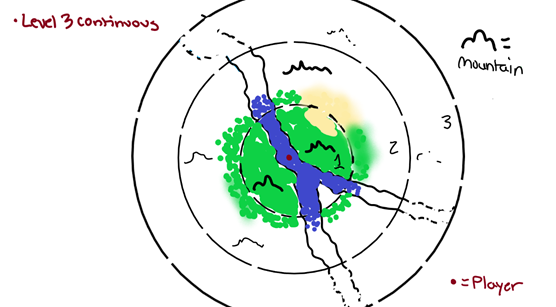
(Sorry for the roughness of the map; I’m not as good as you are!)
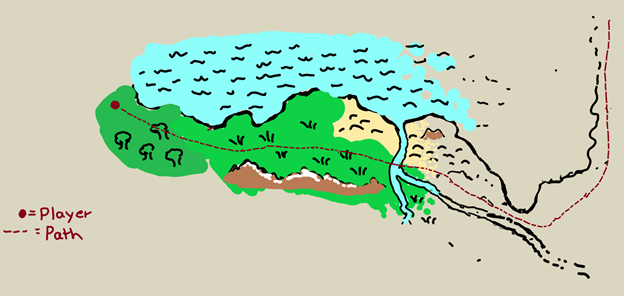
What it would look like on a map
Note that the radius of each layer depends on the organism. Also note that the amount of detail which the player’s organism could fit into each layer depends on the organism itself; for example, an animal with the intelligence of a spider could perhaps have layer 2 be the highest level of detail. There are many variables in this concept that could be tinkered with to represent varying intelligence, and I could probably think up a more in-depth and complex system in regard to representing varying levels of spatial understanding if this concept makes sense.
As a player explores the map, the area they explored will be added to the minimap at the highest layer of detail that a species could use. However, as time goes by, if a player isn’t in an area for a certain amount of time, the detailed layer will eventually fade to the second most detailed layer, until ultimately regressing back into the fog of war. Imagine it almost being akin to Civilisation VI’s map, the only difference being that the 2nd most detailed map layer in Civ VI would eventually fade back into the fog of war:
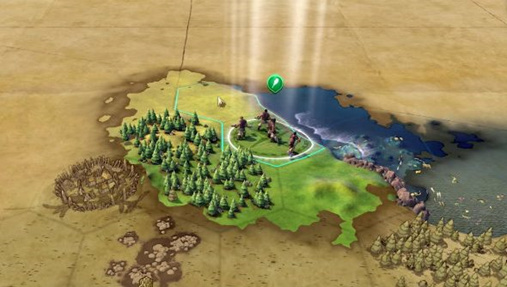
I feel like this could flow with your node and line system that you drew for the microbe stage (which I think could be really cool if implement right) if we could smoothly transition the infographs into the next stage of awareness.
I also feel like this system would allow for a huge range of fun and unique possibilities if we alter the variables a bit for each different species. For example, certain species could have the ability to memorise a certain radius around its birthplace in a detail layer without having to worry about it fading away into detail layer 3, or one species could have the ability to keep information about the map in a certain detail layer for a longer time than other species.
Idea B
Main Question: How can we represent inheritance and learning in a way that could simulate knowledge passed down from generation to generation or could allow for a system of migration?
Thrive could have a progressive trait that could be developed which allows for the transfer of minimap information on a limited scale to the next generation of the player’s organism. At first, the player would basically be starting from scratch from one generation to the next in regard to the minimap; however, if a player invests in a trait which allows for better parenting, the minimap could have a detail layer 2 be passed down from generation to generation. For example, an intelligent creature could pass down a permanently memorized area of the map in detail layer 2 to its offspring, which fades away after that generation and is replaced by the offspring’s memorized area when passed to the offspring’s offspring.
A system like this could be toyed with in a way that represents various phenomenon we see in nature. If a player wants to consistently migrate from generation to generation, they could upgrade a trait to the point at which an organism could memorise a section of the path that could be passed down from generation to generation. If prey item migrates every once in a while and the player wants to mark down a certain part of the migratory pattern for future generations, a player could create a trait which allows for a certain area of the map to be marked down in detail layer 2 during a certain time of the year, representing the instinct found in some animals that we have absolutely no explanation for.
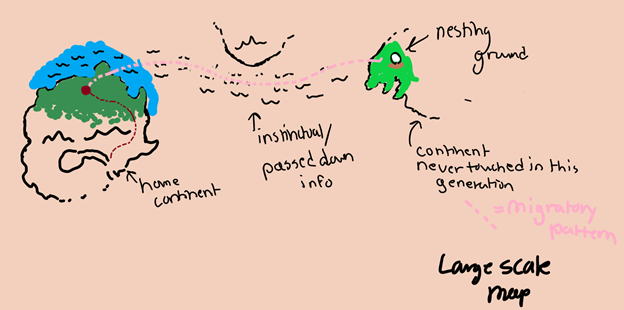
Rough concept of migratory patterns inherited through minimap with adaptations.
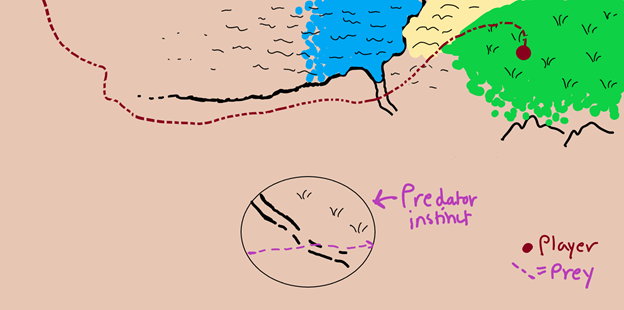
Rough map of a predator’s instinctual awareness of a migratory pattern.
I’ve always wondered the different ways of flying other than just flapping your wings to create lift and thrust.
Is it possible for animals to use similar to jets where the wings remain fixed and the organic turbines suck in air to fly and for the organic jets to shoot air backward to fly? Or is it too far fetched to believe?
The only other way of flying I think would be conceivable would be blimps. An animal produces some light gas (as in light weight), which it stores in a sac on its body. Eventually the animal would start floating, and if it wanted to it could excrete the gas at will.
Yeah that would be a more plausible idea. To phrase my idea better the animal would have to produce some kind of gas and it starts floating, and it can shoot the gas from its air sac to boost its speed, like a jet.
And which gas should be to float, a less dense than air, like hydrogen?I think hydrogen is the more viable gas. (  Interesting… produce hydrogen (its viable) and store in a sac
Interesting… produce hydrogen (its viable) and store in a sac  )
)
Yeah something like that. The real question is how the animal should produce such gas.
There’s one big thing you guys are forgetting, and it’s the reason why we don’t see biological jet engines and blimps on Earth; every adaptation has to come from a previously existing structure, and that structure must be useful in itself for it to see any evolutionary success.
Even if we ignore physical constrains such as the square-cube law and other limitations in morphology, the thing about creatures such as giant blimps and biological jets is that to evolve a giant air bladder or to evolve morphological engines, there had to be a structure from which this adaptation was evolved, and there had to be an immediately useful gain for every single slight generational variation of this structure which led up to the desired structure. There is no foresight in evolution; things don’t evolve in the pursuit of some sort of advanced structure such as a blimp or an engine, things evolve because they work.
Let’s say there’s a creature with an air bladder on land, a creature which would be the ancestor to this living blimp. In order to evolve the ability to drift with this blimp, the animal would have to substantially edit other parts of its body to an extent that enough gas could be filled to allow hovering. It would have to give up any armor that weighs it down, it would have to substantially shrink its limbs to reduce mass, and it would have to go through many millions of years expanding its air bladder bit by bit without any immediate return of value, and would only be able to fly after a gigantic air bladder forms. Through out these millions of years, the animal would have to cope with predators, fluctuating ecosystems and resources, varying food sources, and illness, all while being extremely vulnerable, exposed, and slow as it gives up all of its heavy defensive features in exchange for an air bladder which will only mean anything in 10 million years. I don’t see any large animal having any immediate gain from adapting in such a way; maybe a minuscule, incredibly tiny organism could, but even then, that organism must be able to get enough gas to float and would be too weak to cope with air currents, with the gas putting it at the mercy of wind.
An organism with fixed lift structures and some form of propulsion I think would be more plausible than the living blimps, but even then, I find it difficult to see why a creature would evolve such a method of flight with how effective wings are and how (relatively) easy it is to convert an already existing limb into a traditional wing as opposed to a structure which requires gas-propulsion, which has already been shown to be a questionable strategy. Perhaps a planet with a lower gravity threshold could more plausibly support such life, but even then I would think traditional wings would be more effective, and even then I think other strategies could be more useful.
It is also possible for an animal to have plants growing on it? For example the animal gets nutrients for the plants and the plants give glucose and other stuff in return.
we already have analogs in real life of what you’ve just described on both a micro and macroscopic level. I don’t think it would be too far fetched to assume that this may be possible in thrive in the far future. though i wouldn’t have a single clue how this would be implemented.